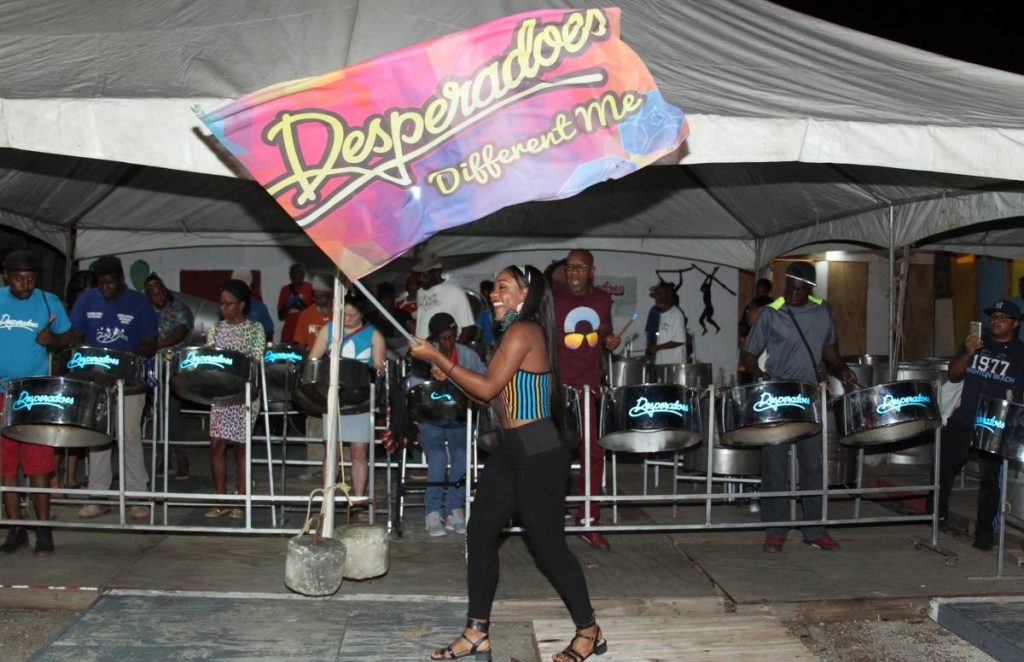Pan and mas, through Desperadoes eyes

“The steelbands concentrated then on masquerading as ‘Sailors’ and ‘African Warriors’. By the late 1950’s, however, a few steelbands began to display original costumes and focus on ‘pretty mas’ such as ... ‘Noah’s Ark’ in 1959 by Desperadoes..."
Rituals of Power & Rebellion, Prof Hollis Liverpool
THE confluence of pan and mas is not a new phenomenon for the Desperadoes Steel Orchestra. For over 65 years, they have demonstrated their intimate connection to the Carnival with portrayals such as To Hell and Back in the 1950s. As one news report recalled, “crawling on their hands, the members put on a live display of war on stage with make-believe smoke screens, gun shots, nurses, the dead and the wounded.”
Last night, the band successfully launched another foray into the world of costumes, proudly showing off designs by Patrick Roberts of Image Nation, with sections like First Notes, Bad Johns and Woman is Boss.
You could be forgiven for wondering why steelbands have Carnival costumes in the first place. After all, masquerade is not their core business. In fact, the truth is that masquerade, Carnival and music are closely intertwined and the pan is a necessary component of that trio. The pioneers on the hill had been experimenting with the pan since the 1930s.
The first time the public got to see the steelpan on the streets is said to be 1940, but it did not explode into the national consciousness until the war ended in 1945. For a considerable time after the conflict was over, the pan served as the musical soundtrack to Carnival. It must be understood that the pan is an instrument of cultural resistance, emerging after almost every other type of musical accompaniment to Carnival was banned. The costuming of the ordinary people was also a problem for the elites, as the rawness of the portrayals offended upper-class sensibilities.
The music and costumes also emerged from a consciousness of resistance to oppression. The former enslaved originally celebrated their Carnival in August to commemorate Emancipation. Through the music and the mas, they cleansed themselves of the horrors of enslavement. They cracked whips, blew conch shells and engaged in stick-fight battles. They were further emboldened by the masks, which summoned African ancestral forms, and allowed a degree of anonymity when they provoked members of the upper classes.
Kalenda bands grounded in stick-fighting traditions began to form as early as the 1840s. The 1860s-1890s saw the predominance of the Jammette Carnival, where masqueraders became more lewd and aggressive as they lashed out against the people who had enslaved them.
Fear and disgust on the part of the governing elite led to numerous laws being passed to limit or ban outright these cultural expressions. Masking was banned just six years after Emancipation.
The drum was banned in 1884, after the Canboulay riots of 1881 stopped Carnival from being permanently cancelled by the colonial administration. In the search for music to accompany their celebration, the tamboo bamboo was invented in 1931; four years later it was banned.
From the 1940s-1960s, the music and costuming began to shift. A growing presence of European instruments such as the violin and the use of string bands made the Carnival more acceptable to the upper classes. They were also soothed by the decline of the Jammette Carnival and the emergence of more subtly costumed presentations.
Changes in costuming were further influenced by the presence of American military bases, visits by naval vessels, an influx of indentured Africans, East Indians and other nationalities, and Hollywood films. Thus, by the time the pan emerged as the instrument of Carnival, it seemed only natural to include costumes depicting themes related to the times.
Attempts to sanitise the Carnival and diminish its essence as a ritual of resistance still continue. However, within communities and in certain elements of the Carnival that understanding is not lost. J’Ouvert, ole mas, stickfight, the Eintou Springer play Kambule and traditional characters like the jab molassie are essential as spiritually cultural creations; in future columns over the season I will explain how.
For now, it is important that Despers has chosen to lay claim to that space occupied by mas and pan. Truth be told, they never really left. As a band, they are connected to our Carnival at many levels, across many realms. So, as you chip to their music and wear their costumes, be aware that you are now linked to their history. Be aware that you chose resistance.
Dara E Healy is a performance artist, communications specialist and founder of the NGO the Indigenous Creative Arts Network, ICAN.


Comments
"Pan and mas, through Desperadoes eyes"